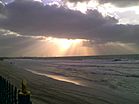Ajman facts for kids
Quick facts for kids
Ajman
عجمان
|
|||||
|---|---|---|---|---|---|
|
City
|
|||||
|
Clockwise from top: Aerial view of Ajman, Corniche Mosque, Ajman beach, Street in Ajman, Ajman Fort Museum
|
|||||
|
|||||
| Country | United Arab Emirates | ||||
| Emirate | Emirate of Ajman | ||||
| Founded | 1750 | ||||
| Government | |||||
| • Type | Monarchy | ||||
| Area | |||||
| • Land | 148 km2 (57 sq mi) | ||||
| Population
(2017)
|
|||||
| • Total | 490,035 | ||||
| GDP | |||||
| • Total | US$ 9.3 billion (2023) | ||||
| • Per capita | US$ 22,600 (2023) | ||||
| Time zone | UTC+4 (UAE Standard Time) | ||||
Ajman is the main city of the Emirate of Ajman in the United Arab Emirates. It's often called the capital of the emirate. Ajman is the fifth-largest city in the UAE. It is smaller than Dubai, Abu Dhabi, Sharjah, and Al Ain. The city is located along the Persian Gulf coast. It is surrounded by the larger emirate of Sharjah.
Contents
What Does Ajman Mean?
The name Ajman comes from an Arabic word. This word is related to "foreigner." This might be because Persians lived in the area a long time ago.
A Look at Ajman's History
Early Rule and Treaties
The Al Nuaimi family began ruling Ajman in 1816. Sheikh Rashid bin Humaid Al Nuaimi took control of the coastal town. His rule was supported by the powerful Sheikh of Sharjah.
In 1820, Sheikh Rashid bin Humaid signed a peace treaty. This was the General Maritime Treaty with the United Kingdom. This treaty helped keep peace in the region.
Ajman in the 1800s
A British survey in 1822 described Ajman. It was a small town with one fortified building, the ruler's house. Many people lived there during the pearl hunting season. They would move to Al Buraimi during the date season.
The ruler of Ajman believed his area was independent. However, Sharjah did not agree. The people of Ajman were mostly strict Wahhabis.
In 1835, Ajman signed another important treaty. This was the Maritime Treaty, which helped end conflicts. In 1843, a new Maritime Treaty was signed. Then, in 1853, a "Perpetual Treaty of Peace" was agreed upon. A copy of this treaty is shown in the Ajman Museum.
Joining the UAE
By the 1900s, Ajman was a small town. It had about 750 people. On December 2, 1971, Ajman joined the United Arab Emirates. This happened under Sheikh Rashid bin Humayd Al Nuaimi.
Population and Location
Ajman city holds most of the emirate's population. More than 90% of the people live here. The city connects directly to Sharjah along the coast. Sharjah then connects to Dubai. This creates a large, continuous urban area.
Business and Shopping
Ajman is an important center for business. It has the Ruler's office and many companies. There are about 50 international and local shops. Many banks also have branches here.
Ajman is also known for its fishing industry. It has companies that import and export seafood. Popular shopping places include Ajman China Mall and City Centre Ajman.
Ajman Free Zone
The Ajman Port and Ajman Free Zone are very important for the economy. The Free Zone can host 1500 companies. It serves over 1,000 ships each year.
Companies in the Free Zone export goods to over 65 countries. About 20% of the UAE's industrial businesses are located here. This includes around 256 industrial companies.
Tourism and Fun
Ajman is growing as a tourist spot. It has seen many new investments. Tourist attractions, hotels, and commercial sites are being improved.
Fun places to visit include Ajman Beach. The Ajman Museum is also popular. It is located in the historic Ajman Fort. The Red Fort and a museum in Manama are also worth seeing.
City Centre Ajman is the emirate's biggest mall. It offers a unique shopping experience. Ajman's corniche is a favorite spot in the evenings and on weekends. It has many restaurants and coffee shops.
The new Al Zorah area offers outdoor activities. You can play golf, use children's play areas, or go kayaking. Ajman was also ranked as one of the safest cities in the world in 2023.
Getting Around Ajman
Ajman has a natural port along a creek. This creek goes into the town. Ajman is also home to Arab Heavy Industries. This is one of the world's largest ship manufacturing companies.
For international flights, people in Ajman can use the Sharjah International Airport. It is only a few kilometers away.
Universities and Colleges
- Ajman University, started in 1988
- City University College of Ajman (CUCA)
- Gulf Medical University
Famous People from Ajman
- Adel Al-Hosani (born 1989), a football goalkeeper
- Kulthum Bin Masoud (born 1957), a journalist, writer, poet, and businesswoman
- Khalfan Mubarak (born 1995), a football player
- Humaid bin Rashid Al Nuaimi (born 1931), the current ruler of the Emirate
Ajman Stud
Ajman Stud is a special horse farm. It was started in 2002 by the Crown Prince of Ajman. His name is H.H. Ammar bin Humaid Al Nuaimi. The farm is about 30 kilometers from Ajman city. In 2016, a horse named Gallardo J won the "Colt Gold" title. H.H. Ammar bin Humaid Al Nuaimi was honored as the best breeder and owner.
See also
 In Spanish: Ajman (ciudad) para niños
In Spanish: Ajman (ciudad) para niños












